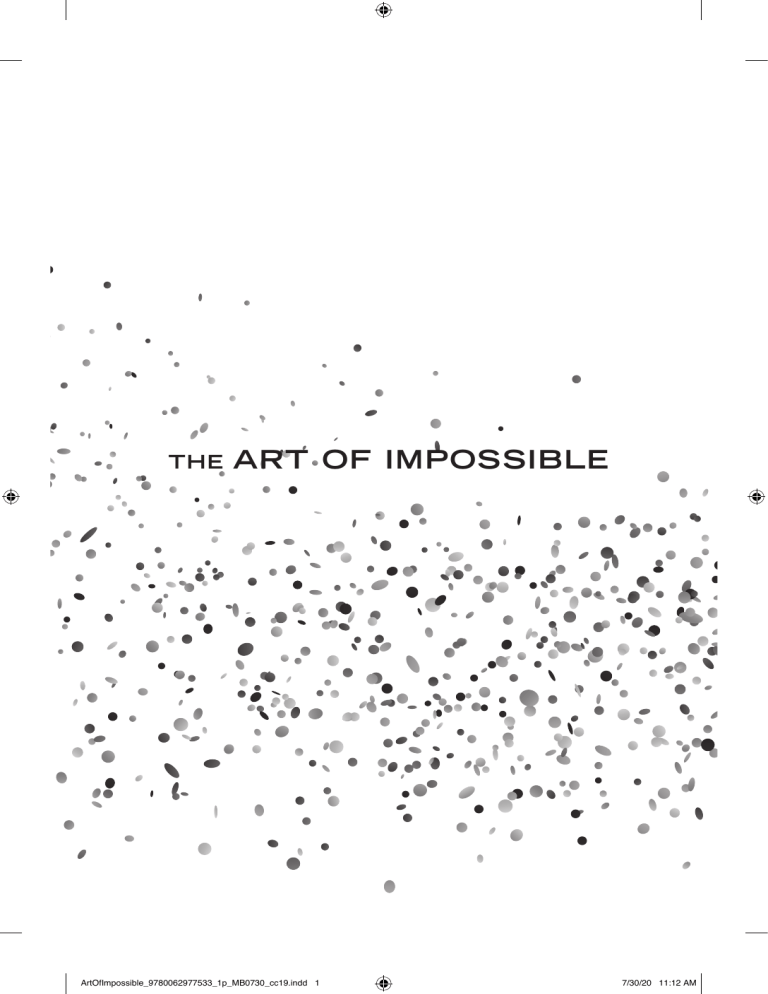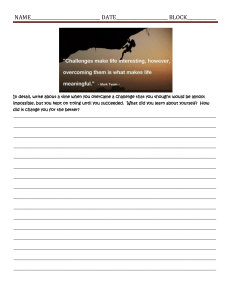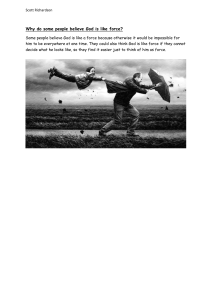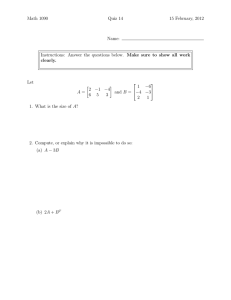
THE ART OF IMPOSSIBLE ArtOfImpossible_9780062977533_1p_MB0730_cc19.indd 1 7/30/20 11:12 AM Part I Motivation If this life not be a real fight, in which something is eternally gained for the universe by success, it is no better than a game of private theatrics from which one may withdraw at will. But it feels like a real fight—­as if there were something really wild in the universe which we . . . are needed to redeem. 1 —­W ILLIAM JAMES ArtOfImpossible_9780062977533_1p_MB0730_cc19.indd 15 7/30/20 11:12 AM 1 Motivation Decoded The central premise of this book is that impossible has a formula. Whenever we see the impossible become possible, we are witnessing the end result of a quartet of skills—­motivation, learning, creativity, and flow—­expertly applied and significantly amplified. The goal of this book is to use science to decipher these skills. We want to get at the basic biological mechanisms that make each of them run, then use what we learn to make them run better—­which is really what I mean by getting our biology to work for us rather than against us. In practice, we are going to work our way through four main sections, exploring motivation, learning, creativity, and flow, in turn. In each section, I’m going to break down what science can tell us about how these skills work in the brain and body, then, through a series of exercises, teach you the best ways to apply this information in your own life. ArtOfImpossible_9780062977533_1p_MB0730_cc19.indd 17 7/30/20 11:12 AM THE ART OF IMPOSSIBLE The place to begin is with motivation, which is what starts us down the path of peak performance. Yet, motivation, as psychologists use the term, is actually a catch-­all for three subsets of skills: drive, grit, and goals. Drive, the subject of the next two chapters, refers to powerful emotional motivators such as curiosity, passion, and purpose. These are feelings that drive behavior automatically.1 This is the big deal. When most people think about motivation, they’re actually thinking about persistence—­meaning the stuff we need to keep going once our drive has left us. Consider the simplest drive: curiosity. When we’re curious about a subject, doing the hard work to learn more about that subject doesn’t feel like hard work. It requires effort, for certain, but it feels like play. And when work becomes play, that’s one way to know for sure: Now, you’re playing the infinite game. Goals, the topic of Chapter Four, are about figuring out exactly where we’re actually trying to go. For a host of neurobiological reasons that will be explored later, when we know where we’re trying to go, we get there much more quickly. Since the road to impossible is long by definition, we’ll need this boost in acceleration to achieve our mission. Grit, the subject of Chapter Five, is the what most people think of when they think of motivation. It’s persistence, determination, and fortitude—­the ability to continue with the journey no matter the difficulty involved. But we’re getting ahead of ourselves. For now, our quest starts with drive. And the reason is simple: there’s really no other option. THE PSYCHOLOGY OF DRIVE Stalking the impossible demands digging deep on a daily basis. Lao-­tzu 18 ArtOfImpossible_9780062977533_1p_MB0730_cc19.indd 18 7/30/20 11:12 AM Motivation Decoded wasn’t wrong: the journey of a thousand miles begins with one step.2 But it’s still a journey of a thousand miles. Uphill, in the dark, both ways. Since impossible is always an arduous trek, elite-­level performers never rely on a single source of fuel to sustain them along the way. And this is true for both physical fuel and psychological fuel. On the physical side, even though this is not the point of this book, elite performers always try to get enough sleep and exercise and maintain proper hydration and nutrition. They “stack”—­that is, cultivate, amplify, and align—­ the foundational requirements for producing physical energy. Equally crucial, elite performers stack psychological fuel sources. They cultivate and align drivers such as curiosity, passion, and purpose. By stacking these sources of mental energy, they ensure on-­ demand access to all of life’s most potent emotional fuels. So what drives us? One way to think about this question is from an evolutionary perspective. We know that scarcity drives evolution. Any problem regularly encountered on a quest to gather resources is a problem that evolution already spent millions of years driving us to solve. Think of evolution as a video game with two main levels. To win on level one, a player must obtain more resources—­food, water, shelter, mates, and so on—­than the other players in the game. On level two, the player must turn those resources into children and help those children survive, either by having so many that there’s no way predators can eat them all (which is what fish do), or by keeping those children safe and teaching them how to obtain resources for themselves (which is the human method). At each level, resource acquisition is key. As discussed, only two strategies are available. Either you fight 19 ArtOfImpossible_9780062977533_1p_MB0730_cc19.indd 19 7/30/20 11:12 AM THE ART OF IMPOSSIBLE over dwindling resources, or you get creative and make more resources. Thus, when we talk about drive from an evolutionary perspective, what we’re really talking about are the psychological fuels that energize behaviors that best solve resource scarcity: fight/flee and explore/innovate. Fear is a psychological driver because it drives us to fight over resources, to flee and avoid becoming someone else’s resources, or to pack up the family and sail across an ocean in a quest to, you guessed it, find more resources. Curiosity is another driver because it makes us wonder if there might be more resources across that ocean. Passion drives us to master the skills required to successfully sail that ocean. Goals drive us because they tell us what resources we’re trying to find on the other side of that ocean and the reason we’re trying to find them. And this list goes on. To make things more manageable, scientists split our psychological drivers into two categories: extrinsic and intrinsic.3 Extrinsic drivers are rewards that are external to ourselves. These are things like money, fame, or sex, and they’re definitely potent. Money translates into food, clothing, and shelter, so the brain treats our desire for it as a basic survival need. Fame might seem trivial, but famous people often have significantly more access to resources—­food, water, shelter, mates, and so on—­so we’re wired to want it. And sex is the only way for humans to win evolution’s game of survival, which is why sex sells and the bars are always packed on Friday night. Intrinsic drivers are the opposite. These are psychological and emotional forces such as curiosity, passion, meaning, and purpose. The pleasure of mastery, which we feel as the sensation of a job well done, is another potent example. Autonomy, the desire to be in charge of one’s own life, is yet another. For most of the last century, researchers believed that extrinsic 20 ArtOfImpossible_9780062977533_1p_MB0730_cc19.indd 20 7/30/20 11:12 AM Motivation Decoded drivers were the more powerful of the pair, but this shifted over the past few decades, as intrinsic drivers have become better understood. What we now know is that there’s a motivational hierarchy at work. External drivers are fantastic, but only until we feel safe and secure—­ meaning that we have enough money to pay for food, clothing, and shelter and have a little left over for fun. In US dollars and today’s economy, the research shows that this is somewhere around $75,000 a year.4 Measure happiness levels among Americans, as Nobel laureate Daniel Kahneman discovered, and they rise in direct proportion to income, but only until we earn about $75,000 a year. After that point, they start to diverge wildly. Happiness becomes untethered to income because, once we can meet our basic needs, the lure of all the stuff it took to meet them begins to lose its luster. Once extrinsic drivers start to fade, intrinsic drivers take over. In business, we see this played out in how companies try to motivate employees. Once people feel fairly compensated for their time—­meaning once that number starts to creep over $75,000 a year—­big raises and annual bonuses won’t actually improve their productivity or performance. After that basic-­needs line is crossed, employees want intrinsic rewards. They want to be in control of their own time (autonomy), they want to work on projects that interest them (curiosity/passion), and they want to work on projects that matter (meaning and purpose). This, too, is evolution at work. It’s not that evolution ever lets us stop playing the “get more resources” game, it’s that our strategy evolves. Once baseline needs are met, you can devote yourself to ways to get, well, you guessed it, seriously more resources—­for yourself, for your family, for your tribe, for your species. As high-­minded as something like “meaning and purpose” might seem as a driver, this is actually evolution’s way of saying: Okay, you’ve got enough resources for yourself and your family. Now it’s time to help your tribe or your species get more. This is also why, in the brain, there’s really not much difference 21 ArtOfImpossible_9780062977533_1p_MB0730_cc19.indd 21 7/30/20 11:12 AM THE ART OF IMPOSSIBLE between drivers. Intrinsic drivers, extrinsic drivers, it doesn’t matter. In the end, like so much of life, it all comes down to neurochemistry. THE NEUROCHEMISTRY OF REWARD Motivation is message. It’s the brain saying: Hey, get off the couch, do this thing, it’s super important to your survival. In order to send this message, the brain relies on four basic components: neurochemistry and neuroelectricity, which are the messages themselves, and neuroanatomy and networks, which are the places those messages are sent from and received. The messages themselves are basic.5 In the brain, electrical signals have only one meaning: do more of what you’re doing. If enough electricity pours into a neuron, that neuron fires, sending that electricity onward to the next neuron. If enough electricity pours into that next neuron, it fires, too. It’s like water in a bucket on a waterwheel. Pour enough water into a bucket, and sooner or later it spills into the next bucket, and the next. It’s that mechanical. Chemical signals are similarly simple, though they can have one of two meanings: do more of what you’re doing, or do less of what you’re been doing. Yet, neurochemicals aren’t intelligent. When we say neurochemicals carry messages—­do more of this or do less of that—­they themselves are the messages. On the inside of synapses, which is the little gap between neurons where neurochemicals do their jobs, there are receptors. Each receptor has a particular geometric shape. Each neurochemical has a particular geometric shape. Either these shapes line up—­so the round neurochemical blob fits inside the round neurochemical blob hole—­or they don’t. If the round key of the neurochemical dopamine fits inside the round lock of a dopamine receptor, then 22 ArtOfImpossible_9780062977533_1p_MB0730_cc19.indd 22 7/30/20 11:12 AM Motivation Decoded the message gets sent. Neuroanatomy and networks, meanwhile, are the places those messages are sent from and received, the where in the brain something is taking place.6 Neuroanatomy describes specific brain structures: the insula or the medial prefrontal cortex. But, in the brain, structures are designed to perform specific functions. The medial prefrontal cortex, for example, aids in decision-­making and the retrieval of long-­term memories.7 So, if a particular “do more” message arrives in the medial prefrontal cortex, the result is more, or sometimes more finely tuned, decision-­ making and long-­term memory retrieval. Networks, meanwhile, refer to brain structures that are hardwired together by direct connections or structures that tend to activate at the same time.8 For example, the insula and the medial prefrontal cortex are wired together and frequently do work at the same time, making them important hubs in the so-­called default mode network. When the brain wants to motivate us, it sends out a neurochemical message via one of seven specific networks.9 These networks are ancient devices, found in all mammals, that correspond to the behavior they’re designed to produce. There is a system for fear, another for anger/rage, and a third for grief or what’s technically known as “separation distress.” The lust system drives us to procreate, the care/nurture system urges us to protect and educate our young. Yet, when we talk about drive—­the psychological energy that pushes us forward—­we’re really talking about the two final systems: play/social engagement and seeking/desire. The play/social engagement system is about all the fun stuff we used to do as kids: running, jumping, chasing, wrestling, and, of course, socializing. Scientists once assumed the point of play was practice. We practice fight today because tomorrow could bring an actual fight for survival. Now, we know that play is mostly designed to 23 ArtOfImpossible_9780062977533_1p_MB0730_cc19.indd 23 7/30/20 11:12 AM THE ART OF IMPOSSIBLE teach us about social rules and social interaction. When you’re playing with your little brother and Mom screams, “Don’t pick on someone smaller than you,” she’s exactly on message. The point of play is to teach us lessons like: might doesn’t make right. It’s nature’s way of instructing us in morality.10 And that instruction occurs automatically. When we play, the brain releases dopamine and oxytocin, two of our most crucial “reward chemicals.” These are pleasure drugs that make us feel good when we accomplish, or try to accomplish, anything that fulfills a basic survival need. Dopamine is the brain’s primary reward chemical, with oxytocin a close second.11 Yet serotonin, endorphins, norepinephrine, and anandamide also play a role. The pleasurable feeling created by each of these chemicals drives us to act and, if that action was successful, reinforces the behavior in memory. Moreover, neurochemicals are specialized. Dopamine specializes in driving all the various manifestations of desire, from our sexual appetites to our quest for knowledge. We feel its presence as excitement, enthusiasm, and the desire to make meaning from a situation. When your phone dings, and you’re curious to check it out, that’s dopamine at work. The urge to decipher black hole theory, the hunger to climb Mount Everest, the desire to test your limits—­that’s dopamine, too. Norepinephrine is similar but different. It’s the brain’s version of adrenaline, sometimes called noradrenaline. This neurochemical produces a huge increase in energy and alertness, stimulating both hyperactivity and hypervigilance. When you’re obsessed with an idea, can’t stop working on a project, or can’t stop thinking about the person you just met, norepinephrine is responsible. Oxytocin produces trust, love, and friendship.12 It’s the “pro-­ social” neurochemical that underpins everything from loving, long-­ term marital bliss to cooperative, well-­f unctioning companies. We feel 24 ArtOfImpossible_9780062977533_1p_MB0730_cc19.indd 24 7/30/20 11:12 AM Motivation Decoded its presence as joy and love. It promotes trust, underpins fidelity and empathy, and heightens cooperation and communication. Serotonin is a calming, peaceful chemical that provides a gentle lift in mood.13 It’s that satiated feeling that comes after a good meal or a great orgasm, and it’s partially responsible for that post-­meal/post-­ coital urge to take a nap. But it also appears to play a role in satisfaction and contentment, that feeling of a job well done. Endorphins and anandamide, our final two pleasure chemicals, are pain-­killing bliss producers. They’re both heavy-­duty stress relievers, replacing the weight of the everyday with a euphoric sense of relaxed happiness. It’s that “all is right in the world” sensation that shows up during experiences like runner’s high, or when we catch our second wind. Yet the neurochemistry of reward isn’t simply about how individual neurochemicals work, as we’re often motivated by combinations of neurochemicals. Dopamine plus oxytocin is the blend beneath the delight of play. Passion—­including everything from the passion of an artist for their craft to the passion of romantic love—­is underpinned by the pairing of norepinephrine and dopamine.14 Flow may be the biggest neurochemical cocktail of all. The state blends all six of the brain’s major pleasure chemicals and appears to be one of the only times you get all six at once. This potent mix explains why people describe flow as their “favorite experience,” while psychologists refer to it as “the source code of intrinsic motivation.” The seeking/desire system is the second system that plays an important role in drive. Sometimes called the “reward system,” this is a general-­purpose network that helps animals acquire the resources they need for survival. “In pure form, [the seeking system] provokes intense and enthusiastic exploration and . . . anticipatory excitement [and] learning,” writes Jaak Panksepp, the neuroscientist who discovered these seven systems.15 “When fully aroused, the seeking system 25 ArtOfImpossible_9780062977533_1p_MB0730_cc19.indd 25 7/30/20 11:12 AM THE ART OF IMPOSSIBLE fills the mind with interest and motivates organisms to effortlessly search for the things they need”—­italics mine. I put “effortlessly” into italics for a reason. If we can tune the system correctly, the results show up automatically. Consider passion. When we’re passionate, we don’t have to work hard to stay on task. Because of dopamine and norepinephrine, that happens automatically. Every day, I wake up at 4:00 a.m. and start writing. Does this demand grit? Occasionally. But mostly, grit takes care of itself because I have curiosity, passion, and purpose. When I wake up, I’m excited to see where the words will take me. Even on those crappy nights when I wake up in a panic, I retaliate by writing. Writing is where I run when I need to run. My craft is my salvation. And if you talk to anyone who has tackled the impossible, you’ll hear a similar tale. Consider the late, great skier and skydiver Shane McConkey.16 As much as any athlete in history, McConkey extended the limits of human possibility, not just accomplishing the impossible but doing so again and again. And if you asked McConkey how he pulled this off, his answer frequently stressed the importance of intrinsic drive: “I’m doing what I love. If you’re doing what you want to do all the time then you’re happy. You’re not going to work every day wishing you were doing something else. I get up and I go to work every day and I’m stoked. That does not suck.” Yet, the same neurochemical drive that helped Shane McConkey accomplish the impossible is available to all of us. It’s our basic biology at work, the push of our most critical emotional fuels, expertly cocktailed for maximum thrust. THE RECIPE FOR DRIVE Over the next two chapters, we’re going to learn to stack—­that is, 26 ArtOfImpossible_9780062977533_1p_MB0730_cc19.indd 26 7/30/20 11:12 AM



